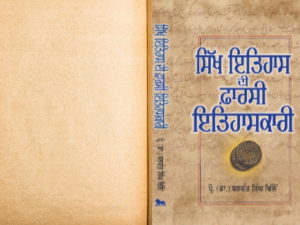Introduction
In the Sikh scripture, Sri Guru Granth Sahib (SGGS), Guru Nanak describes the attributes of Ultimate Reality (God) as follows [1]:
ੴ ਸਤਿ ਨਾਮੁ ਕਰਤਾ ਪੁਰਖੁ ਨਿਰਭਉ ਨਿਰਵੈਰੁ ਅਕਾਲ ਮੂਰਤਿ ਅਜੂਨੀ ਸੈਭੰ ਗੁਰਪ੍ਰਸਾਦਿ ॥
Ultimate Reality is one and non-dual. The Supreme Reality is true and it is manifested in Truth, Existence and Being. The other features of Reality are its transcendence and immanence, creator person, without fear or hatred, beyond time and space, self-existent, transcendental cosmic spirit made manifest by grace of the Guru.
The first attribute ੴ (pronounced generally as Ik-Oankar or Ek-Ongkar) is the most fundamental concept of Guru Nanak, the founder of Sikh religion. In Sikh religion, God is represented by a unique alphanumeric divine symbol, ੴ, called a logo by Eleanor Nesbitt and DS Chahal [2,3]. Nikky-Guninder Singh [4] illustrates that three modes of knowledge have been used to signify the Divine symbol - numerical, alphabetical, and geometrical. Significantly, the prime number ‘1’ is recognized by individuals of all languages, cultures and religions. It is followed by the alpha of the Gurmukhi script, which is the sign for One (Being) and completed by the sign for Kar (Is), a geometrical arc reaching away into space. This doctrine of oneness is frequently expressed by Guru Nanak and his successor Gurus throughout the SGGS [5]:
ਏਕੋ ਏਕੁ ਏਕੁ ਹਰਿ ਆਪਿ॥ Ėko ek ek har āp.
The One Lord Himself is the One and Only.
(SGGS, M.5, P. 289)
ਏਕੋ ਕਹੀਐ ਨਾਨਕਾ ਦੂਜਾ ਕਾਹੇ ਕੂ॥ Ėko kahī▫ai nānkā ḏūjā kāhe kū.
Speak of the One Lord, O Nanak; how could there be any other?
(SGGS, M. 1, P. 1291)
Reflections and Interpretations of Ik Oankar
DS Chahal [6] has recently published a special issue (Silver Jubilee) of Understanding Sikhism: The Research Journal which has nearly a dozen articles on concept of God in different religions of the world. There are two articles: ੴ by DS Sekhon [7] and “Ik Onkar: Some Reflections” by Eleanor Nesbitt [8] dealing with the topic for discussion in my paper. I have made liberal use of their ideas as I find both these authors at the same wavelength, or in resonance with my ideas.
According to Sekhon: “ੴpronounced as “Ikk Onkar” “Ek Onkar” or as “Ekunkar” is the most fundamental belief of Sikhism, and the contents of the whole Sri Guru Granth Sahib revolve around it. It signifies that there is only one Supreme Being in the universe, which is also the creator of the universe. The numeral “1” of the Symbol emphasizes that there is only “1” Supreme Being. The openness of the letter “Oora” in ੴ signifies that the Supreme Being, which is popularly addressed as Waheguru, Akalpurakh, Kartar, or by many other names, is omnipresent and fills the entire universe, and is not restricted to certain places. Its other forms, “Ikk Onkar” and “Ekonkar or Ekunkar,” could have been misinterpreted by some vested interests as the word “Omkar.” which had been in use in Hindu holy books long before Guru Nanak Sahib, who coined this unique name for the Supreme Being, and described His unique traits in the so-called Mool Mantra (a sort of invocation to God)”.
Sekhon tries to justify the pronunciation of ੴ: “Etymologically, the word “Ekunkar” is made up of two syllables – Ek and Onkar. So, the correct pronunciation of the symbol ੴ is “Ikk Onkar” or “Ekunkar.” He goes on to prove that Guru Nanak and Bhagat Kabir in SGGS reject the trinity of Hindu Gods and do not subscribe to the concept of “OM” as understood in the Indian tradition. However, Sekhon finds a reconciliation of Hindu “OM” and Sikhi “IKONKAR” in the new coinage used by Guru Nanak in SGGS: “Keeping the tradition of the Bhagats not to change the popular names of the gods whom the people worshipped, believing them to be the Supreme Beings, Guru Nanak Sahib did not change the name “Omkar(u)” for the Supreme Being, but changed its meaning and the basic concept. He added the numeral “1” before it and called it “EK-ONKAR” meaning that there is only one Supreme Being - and not many - and gave it the symbol, ੴ.”
Sekhon’s conclusion may raise eyebrows of certain Sikh scholars who want to disentangle Sikhi from Hindu tradition. He concludes: “So, even though the origin of the holy word “Ek Onkar” may lie in “Omkar” Guru Nanak Sahib gives it a different pronunciation and a completely different meaning – that the word “Omkar” stands for Ek-Onkar which means there is only one Supreme Being”.
Nesbitt [8] has explained the historical development of use of Ik-Onkar in Sikh studies starting with Annie Besant and Dorothy Field. She approvingly quotes that the numeral [ik] transcends differences of geography, gender and culture, and impressions tied to different religious identities and traditions [9]. She tries to elaborate and internationalise Ik-Oankar as a symbol of Sikhi: “So, not only is the spoken ‘ik oankar’ supremely powerful, including as it does the resonance of the ancient Indic “om”, but the visual symbol is potent too. While visually encapsulating Guru Nanak’s primary teaching, it conveys the conviction, over successive centuries, of the panth (those following the Guru’s way), and so it has become a signifier of Sikhs worldwide. In a religiously diverse world, emblematically, ‘ik oankar’, interchangeably with the weapon-based khanda symbol of the Khalsa, stands alongside the Christians’ cross, Muslims’ crescent and Hindus’ swastika and om”.
Nesbitt concludes: “What is clear is that ik oankar, both visually as a symbol and logo and orally as a reverberating statement and invocation, not only unites today’s Sikhs but also connects Sikhs across the generations from the days of Guru Nanak and that it will continue to do so on into the future. May ik oankar continue to illuminate and reflect the questing of Sikhs and other spiritual seekers”. She is the first author to use “logo” for Ik Oankar which was adopted by Chahal in his publication [10] later on.
There are many Sikh and non-Sikh scholars who have contributed their views on Guru Nanak’s concept of Ik Oankar. DP Singh gives a brief description of Ik Oankar [11]: “Guru Nanak's most fundamental concept of God is expressed in the term "Ik Onkar," which means "One Universal Creator" or "One God." It signifies the belief in the oneness and unity of God, who is the sole creator and sustainer of the universe”. However, Chahal has made a sterling contribution to interpret the concept of Guru Nanak’s Ik Oankar in his publications [3, 12-15].
Chahal is highly critical of the approach of the Sikh scholars pronouncing Ik Oankar in the traditional way which compromises its originality as conceived by Guru Nanak. “The logo, ੴ, is generally pronounced by many Sikh theologians and scholars as ਏਕੁ ਓਅੰਕਾਰੁ (Ek Oankaar) or ਏਕੁ ਓਮਕਾਰੁ (Ek Aumkaar). The survey of the available literature indicates that the early Sikh theologians under the heavy influence of ancient philosophy have pronounced it as such because the writing of 'Oankaar' or 'Aumkaar' or ‘Aum’ or ‘Om’ on the top of every writing was very common in ancient literature”.
He started on his journey of exploration after watching a TV show: “It was during a TV show that I saw it being spelt as Ikk Omkar. It appeared as if someone was trying to give Sikhi a Vedic twist. This raised two questions in my mind pertaining to ੴ. First, what was the correct pronunciation; and second what was the message behind this Symbol/ word, ੴ as intended by Guru Nanak”.
He blames Bhai Gurdas, the Sikh savant and scribe of SGGS, for the current pronunciation of Ik Oankar: “However, I have noticed that Bhai Gurdas might be the first Sikh scholar trained at Banaras (Varanasi) who has pronounced ੴ as ਏਕੁ ਓਅੰਕਾਰੁ (Ek Oankaar) as is evident from his Pauri 15 of Vaar 3 [16]. Thereafter, other Sikh scholars followed Bhai Gurdas’ pronunciation of ੴ. It also appears that Bhai Gurdas was the first who declared the Commencing Verse as Mool Mantra and as ਏਕੁ ਓਅੰਕਾਰੁ (Ek Oankaar) which leads the Sikhs to Vedas and Vedanta philosophies since Mantra system is from Vedas and Oankar/Aumkar/Omkar represents Aum/Om which further represents Trinity of God. On the other hand, neither the Mantra system nor the Trinity of God is accepted by Guru Nanak”.
Chahal asserts that pronunciation of Ik Oankar ੴ must correspond to the design of this logo containing numeral 1, Gurmukhi alphabet open Oora ਓ, and extended line (). Therefore, ੴ can be pronounced as ਇਕੁ ਓ ਬੇਅੰਤ (Ek Oh Beant) in Punjabi and as 'The One and Only, ‘That is Infinite' in English [17]. He argues that extended line stands for 'Infinite' meaning (ਬੇਅੰਤ). At the time of Guru Nanak, there was no specific way or word to express ‘infinite’ in any symbol except an open line that can be extended at both ends to any unlimited length. However, I am of the opinion that this pronunciation was introduced by Nirmal Kalsi of Surrey [18] before it was modified and used by Chahal.
Why Chahal is so adamant about his discovery of a new pronunciation? The only explanation is that he considers the majority of the Sikh scientists, theologians and the Sikhs at large still insist to pronounce ੴ as ਏਕੁ ਓਅੰਕਾਰੁ (Ek Oankaar) because Guru Nanak has used ਓਅੰਕਾਰੁ (Oankaar) several times in the first stanza of ਓਅੰਕਾਰੁ (Oankaar) Bani in SGGS. Nevertheless, ੴ cannot be considered as ਓਅੰਕਾਰੁ (Oankar) since it represents OM according to the Upanishads which represents Trinity of God: Brahma, Vishnu, and Shiva.
Before we conclude this section, let us refer to a recent publication by a well-established author, SS Bhatti [19], who has thrown a spanner in the ongoing proposal for calling Ik Oankar ੴ a logo. He is highly critical of our new breed of Sikh scholars, especially Sikh scientists: “At the outset, I would like to take up two moot issues concerning the Sikh Faith so that at least my point of view is clear to my readers: (1) Some scholars who follow the Sikh Faith have stubborn aversion for the sound of the sacred word “Omkar” and in unnecessary resistance insist that the new coinage “Oankar" is original and has nothing to do with the centuries-old “Gur-Mantra”, and (2) at least there is one scholar of the same clan who has gone a step further to declare that “Ik Oankar” [] Guru Nanak Dev’s Timeless-Universal Guru-Mantra is no more than a “Logo” used by the Prophet of Sikhi. Om is an ancient mantra that is used in Hinduism and Buddhism. In the Hindu tradition, the sound of Om is said to contain the entire universe. It is the first sound from the beginning of time, and it also encompasses the present and the future. As such, its importance and power are difficult to overstate.
Therefore, to call it “Logo” [and say it is “one word”] is unpardonable sacrilege. Only an illiterate or ignorant person would commit it in the name of scholarship or scholastic investigation. In any case, “Ik Oankar” is not a word; it is composed of a ‘Numeral’ [੧] and the open ‘Oorha’ [ਓ]. By this token, it is not at all a “Logo” because Guru Nanak Dev was not marketing it as merchandise of the Sikh Faith—it just dawned on him because the Lord had chosen him for an unprecedented divine mission”.
IKONKAR: An Insignia of Unification of World Religions
Our reflections and interpretations of Ik Oankar justify to claim its acceptance as a Symbol or Insignia of “Unity in Diversity” of World religions. As a Physicist, we are looking for a unification theory of fundamental forces explaining physical phenomena in the Universe. In my view, in the spiritual world, Guru Nanak’s concept of Ik Oankar has all the potential to serve as a unifying force of world religions. All symbols and philosophies of major world religions, namely. Hinduism, Buddhism, Islam, Judaism, and Christianity merge into Ik Oankar. The OM of Hindus, monotheism of Islam and other occidental religions find an echo in Ik Oankar.
Simrinjeet Singh delivers the message of unification forcefully in his recent book [20]: “Ik Oankar refers to the oneness of reality, the one divine force that connects us all. In embracing the message of ik oankar, we recognize that there is a divine spark within each and every one of us, regardless of our backgrounds or beliefs. We are all interconnected, and our actions have the ability to impact the larger fabric of humanity. By practicing ik oankar, we can see the divine light in others and treat them with respect, compassion, and love”.
Amardeep Singh has created a 24 Episode Documentary Series on Guru Nanak, an embodiment of Oneness, under the title “Allegory - A Tapestry of Guru Nanak’s Travels” [21] in five languages (English, Hindi, Punjabi, Urdu, and Shahmukhi). These docuseries are spreading the message of love and peace.
REFERENCES
References in Text are from SGGS (Sri Guru Granth Sahib). (M = 1, 2, 3, 4, 5, represents the succession number of the Sikh Gurus to the House of Guru Nanak), P = Page of the SGGS. Publishers: Shiromani Gurdwara Parbandhak Committee, Golden Temple Press, Amritsar.
- SGGS, Japu Bani, P. 1)
- Eleanor Nesbitt. SIKHISM. A Very Short Introduction. OUP, 2005.
- DS Chahal. Understanding ੴ-Designed by Guru Nanak to represent Eternal Entity (God). Sikh Philosophy Network (SPN), 18 August, 2020.
- Nikky-Guninder K. Singh. Sikshism: An Introduction. I.B. Tauris& Co Ltd, New York, 2011.
- HS Virk. Concept of God: The Ultimate Reality in Sikh Religion. Understanding Sikhism: The Research Journal, Silver Jubilee special Issue, Jan-Dec. 2023, Vol. 25(1), pp. 51-56.
- DS Chahal. Editor, Understanding Sikhism: The Research Journal. Silver Jubilee Special Issue, Jan-Dec. 2023, Vol. 25, No. 1.
- Devinder Singh Sekhon. ੴ. Understanding Sikhism: The Research Journal. Silver Jubilee Issue, Jan-Dec. 2023, Vol. 25 (1), pp. 67-71.
- Elenor Nesbitt. Ik Oankar: Some Reflections. Understanding Sikhism: The Research Journal, Silver Jubilee Issue, Jan-Dec. 2023, Vol. 25(1), pp. 5-6.
- Harinder Singh. Jewels from Sikh Wisdom: A Journey of Discovery, Yorba Linda: Sikhlens Publications, 2022.
- DS Chahal. ੴ: The Unique Logo. Understanding Sikhism Res. J. 2011, p.18. http://www.iuscanada.com/journal/archives/2011/j1312p18.pdf.
- DP Singh. Concept of God in Guru Nanak’s Hymns. Understanding Sikhism: The Research Journal, Silver Jubilee Issue, Jan-Dec. 2023, Vol. 25(1), pp. 57-65.
- DS Chahal. The Commencing Verse of the Aad Guru Granth Sahib. Understanding Sikhism Res. J. 2000, 2 (1), pp. 8-19.
- DS Chahal. JAP: The Essence of Nanakian Philosophy. Institute for Understanding Sikhism, Laval, Quebec, Canada. Distributors: Singh Brothers, Amritsar, 2003.
- DS Chahal. A Unique Concept of God in Nanakian Philosophy. Understanding Sikhism Res. J. 2002, 4 (2), pp. 5-15.
- DS Chahal. Oankaar or Omkaar: The Misunderstood Word - Annotation by Guru Nanak. Understanding Sikhism Res. J. 2005, 7 (2), p. 17.
- Bhai Vir Singh. Vaaran Bhai Gurdas Steek (Punjabi), Hall Bazar, Amritsar, Khalsa Samachar, 1984.
- DS Chahal. JAP: The Essence of Nanakian Philosophy (a Scientific and Logical interpretation) (Revised Version), Singh Brothers, Amritsar, 2018.
- Nirmal S. Kalsi. (1996) Beej Mantar Darshan (Punjabi). Publisher: Kalsi Technologies, # 15, 7711 - 128th Street, Surrey, BC, Canada.
- SS Bhatti. GURU NANAK DEV ─ Dispenser of Love and Light. White Falcon Publishing, Chandigarh, 2019.
- Simran Jeet Singh. The Light we Share: How Sikh Wisdom can Transform your Life. New York: Riverhead Books, 2022.
Amardeep Singh. https://thegurunanak.com. available free online.






